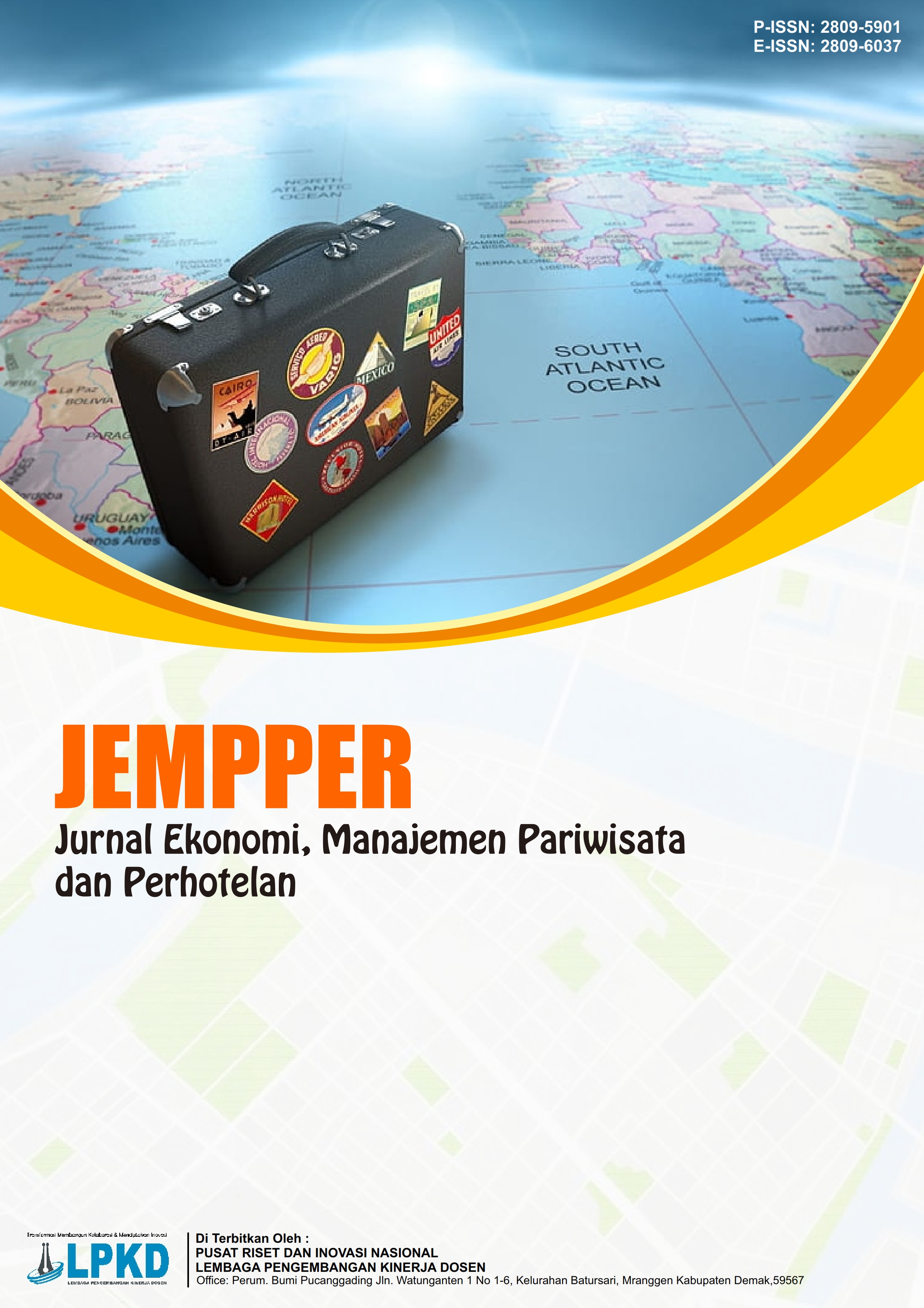Strategi Pengembangan Sektor Perikanan Air Alut di Kota Bengkulu untuk Peningkatan Ekonomi Lokal
DOI:
https://doi.org/10.55606/jempper.v4i3.5010Keywords:
Bengkulu, Development, Fisheries, Strategy, SWOT AnalysisAbstract
This study aims to formulate a strategy for the development of the seawater fisheries sector in Bengkulu City using a SWOT (Strengths, Weaknesses, Opportunities, Threats) analysis approach. The city of Bengkulu has a huge marine potential with a wealth of fish resources with high economic value, such as tuna, snapper, grouper, and various other types of marine products. This potential should be optimally utilized to improve the welfare of coastal communities, open up export opportunities, and encourage regional economic growth. However, the utilization of this potential is still not optimal due to various obstacles, including limited port infrastructure, traditional fishing technology, inadequate cold chain facilities, and limited market access. This study uses a descriptive qualitative method by collecting primary data through in-depth interviews, group discussions, and direct observation in the Baai Island and PPI Pondok Besi areas. Secondary data were obtained from government reports, fisheries offices, and literature reviews related to marine sector management policies. The results of the study show that the main strength of this sector lies in the strategic geographical location of Bengkulu City, the potential for abundant natural resources, and the support of maritime culture of the local community. Existing opportunities include government policies that support the development of the fisheries sector, increasing export market demand, and the potential for the development of marine products-based downstream industries. The weaknesses found are the lack of training for fishermen, the limitations of modern equipment, and storage facilities for catches. The threats faced include climate change, extreme weather, and competition with other fish-producing areas. The development strategies formulated include SO, WO, ST, and WT strategies with the aim of optimizing strengths and opportunities, overcoming weaknesses, and minimizing threats.
References
Alexsander, A., & Harmiati, H. (2024). Grand strategy penguatan resiliensi kelompok nelayan tradisional di Desa Pesisir Bengkulu Tengah. Jurnal Ilmu Sosial dan Humaniora, 13(1), 13–27.
Allvitro, B., Ridwan, G., Guevarrato, G., & Bakti, R. A. (2023). Studi tata kelola anggaran sanitasi, air minum dan persampahan untuk nelayan tahun 2019–2022.
Anafi, K., Wiryokusumo, I., & Leksono, I. P. (2021). Pengembangan media pembelajaran model ADDIE menggunakan software Unity 3D. Jurnal Education and Development, 9(4), 433–438.
Anwar, M. (2020). Manajemen strategik: Daya saing dan globalisasi. Sasanti Institute.
Arianto, M. F. (2020). Potensi wilayah pesisir di Negara Indonesia. Jurnal Geografi, 10(1), 204–215.
Darsyah, S. (2023). Model deskriptif manajemen strategik: Proses manajemen strategik, lingkungan eksternal, lingkungan internal, formulasi strategi. Jurnal Adzkiya, 7(1), 46–58.
Fauzi, A. (2010). Ekonomi perikanan: Teori, kebijakan, dan pengelolaan. PT Gramedia Pustaka Utama.
Fitri, M. A., & Usni, M. (2023). Strategi pengembangan agro maritim di wilayah pesisir Kota Padang Sumatera Barat. Prosiding Seminar Nasional Hasil Penelitian Kelautan dan Perikanan, 90–95.
Haque-Fawzi, M. G., Iskandar, A. S., Erlangga, H., & Sunarsi, D. (2022). Strategi pemasaran: Konsep, teori dan implementasi. Pascal Books.
Khaldun, R. I. (2017). Strategi kebijakan peningkatan daya saing rumput laut Indonesia di pasar global. Sospol, 3(1), 99–125.
Latuconsina, H. (2019). Ekologi perairan tropis: Prinsip dasar pengelolaan sumber daya hayati perairan. UGM Press.
Nurhayati, A., Pical, V., Erfani, A., Hilyaa, S., Saloko, S., Made, S., & Purnomo, A. H. (2020). Manajemen risiko perikanan tangkap (Studi kasus di tengah pandemi COVID-19). Journal of Fisheries and Marine Research, 4(3), 417–427.
Ramlah, S., Adimu, H. E., Asni, A., & Fekri, L. (2022). Pengembangan usaha perikanan tangkap skala kecil di Kabupaten Kolaka, Sulawesi Tenggara. Jurnal Kebijakan Sosial Ekonomi Kelautan dan Perikanan, 12(1), 1–10.
Rangkuti, F. (1998). Analisis SWOT: Teknik membedah kasus bisnis. Gramedia Pustaka Utama.
Saputra, G. A., Kustiari, T., & Djamali, A. (2024). Strategi pengembangan budidaya perikanan ikan nila Kabupaten Jember. Kunkun: Journal of Multidisciplinary Research, 1(2), 139–150.
Saputra, N., Nuraini, Y., & Yuniarti, T. (2020). Identifikasi potensi wilayah perikanan di Kecamatan Air Rami Kabupaten Mukomuko Provinsi Bengkulu. Jurnal Penyuluhan Perikanan dan Kelautan, 14(1), 93–105.
Sinarwati, N. K., Sujana, E., Kertiasih, N. K., & Al Insani, I. (2023). Digitalisasi badan usaha milik desa dalam mewujudkan pertumbuhan ekonomi desa merata. Prosiding Seminar Nasional UNARS, 2(1), 548–556.
Snekubun, E., Suwarno, P., & Prakoso, L. Y. (2024). The impact of Gina Raimondo’s strategic policy in the maritime economy in the United States and its relevance to Indonesia. Indonesian Journal of Interdisciplinary Research in Science and Technology, 2(9), 1325–1336.
Teoli, D., Sanvictores, T., & An, J. (2019). SWOT analysis. StatPearls Publishing.
Tribawono, I. H. D. (2018). Hukum perikanan Indonesia. PT Citra Aditya Bakti.
Wati, L. A., & Primyastanto, M. (2018). Ekonomi produksi perikanan dan kelautan modern: Teori dan aplikasinya. Universitas Brawijaya Press.
Whittington, R. (2008). Alfred Chandler, founder of strategy: Lost tradition and renewed inspiration. Business History Review, 82(2), 267–277.
Zamdial, Z., Muqsit, A., & Wulandari, U. (2020). Pemetaan daerah penangkapan ikan (fishing ground) nelayan Kota Bengkulu, Provinsi Bengkulu. Jurnal Enggano, 5(2), 205–218.







